Deck 13: Fiscal Policy
Question
Question
Question
Question
Question
Question
Question
Question
Question
Question
Question
Question
Question
Question
Question
Question
Question
Question
Question
Question
Question
Question
Question
Question
Question
Question
Question
Question
Question
Question
Question
Question
Question
Question
Question
Question
Question
Question
Question
Question
Question
Question
Question
Question
Question
Question
Question
Question
Question
Question
Question
Question
Question
Question
Question
Question
Question
Question
Question
Question
Question
Question
Question
Question
Question
Question
Question
Question
Question
Question
Question
Question
Question
Question
Question
Question
Question
Question
Question
Question

Unlock Deck
Sign up to unlock the cards in this deck!
Unlock Deck
Unlock Deck
1/115
Play
Full screen (f)
Deck 13: Fiscal Policy
1
An example of fiscal policy would be government:
A) increasing the amount of available educational grants.
B) decreasing the income tax.
C) increasing corporate income taxes.
D) increasing money supply.
A) increasing the amount of available educational grants.
B) decreasing the income tax.
C) increasing corporate income taxes.
D) increasing money supply.
increasing money supply.
2
Fiscal policy is:
A) government decisions about the level of taxation and public spending.
B) congressional budget office decisions.
C) the decisions that affect the available money supply in the economy.
D) government decisions about the level of the interest rate in the economy.
A) government decisions about the level of taxation and public spending.
B) congressional budget office decisions.
C) the decisions that affect the available money supply in the economy.
D) government decisions about the level of the interest rate in the economy.
government decisions about the level of taxation and public spending.
3
Government decisions about the level of taxation and public spending are called:
A) fiscal policy.
B) monetary policy.
C) congressional policy.
D) legislative budgeting policy.
A) fiscal policy.
B) monetary policy.
C) congressional policy.
D) legislative budgeting policy.
fiscal policy.
4
If the government wished to shift aggregate demand to the right, it might:
A) increase government spending.
B) increase income taxes.
C) pressure the Fed to decrease the money supply.
D) Any of these things might cause aggregate demand to shift to the right.
A) increase government spending.
B) increase income taxes.
C) pressure the Fed to decrease the money supply.
D) Any of these things might cause aggregate demand to shift to the right.

Unlock Deck
Unlock for access to all 115 flashcards in this deck.
Unlock Deck
k this deck
5
Rising unemployment and decreased business confidence could be signs that the economy is at the start of a(n):
A) recession.
B) boom.
C) recovery.
D) expansion.
A) recession.
B) boom.
C) recovery.
D) expansion.

Unlock Deck
Unlock for access to all 115 flashcards in this deck.
Unlock Deck
k this deck
6
According to the text, The American Recovery and Reinvestment Act of 2009:
A) was successful.
B) was unsuccessful.
C) remains hotly debated whether it was successful or not.
D) is known as the most effective legislation ever passed in U.S. history.
A) was successful.
B) was unsuccessful.
C) remains hotly debated whether it was successful or not.
D) is known as the most effective legislation ever passed in U.S. history.

Unlock Deck
Unlock for access to all 115 flashcards in this deck.
Unlock Deck
k this deck
7
Republicans often argue in favor of what to push the economy toward economic recovery, as they did during the recession that began in 2008?
A) Tax cuts
B) Increase government spending
C) Decrease government spending
D) Encourage the public to save more
A) Tax cuts
B) Increase government spending
C) Decrease government spending
D) Encourage the public to save more

Unlock Deck
Unlock for access to all 115 flashcards in this deck.
Unlock Deck
k this deck
8
By 2016, the unemployment rate in the US had fallen from a peak of 10% in 2009 to:
A) under 5%.
B) 7.8%.
C) 6.2%.
D) under 3%.
A) under 5%.
B) 7.8%.
C) 6.2%.
D) under 3%.

Unlock Deck
Unlock for access to all 115 flashcards in this deck.
Unlock Deck
k this deck
9
Democrats often argue in favor of what to push the economy toward economic recovery, as they did during the recession that began in 2008?
A) Tax cuts
B) Increase government spending
C) Decrease government spending
D) Encourage the public to save more
A) Tax cuts
B) Increase government spending
C) Decrease government spending
D) Encourage the public to save more

Unlock Deck
Unlock for access to all 115 flashcards in this deck.
Unlock Deck
k this deck
10
One way fiscal policy affects aggregate demand is:
A) directly through government spending.
B) directly through tariffs.
C) directly through taxation.
D) All of these are true.
A) directly through government spending.
B) directly through tariffs.
C) directly through taxation.
D) All of these are true.

Unlock Deck
Unlock for access to all 115 flashcards in this deck.
Unlock Deck
k this deck
11
If the government were to increase its spending, it would expect:
A) aggregate demand to shift to the right.
B) aggregate demand to shift to the left.
C) aggregate supply to shift to the right.
D) aggregate supply to shift to the left.
A) aggregate demand to shift to the right.
B) aggregate demand to shift to the left.
C) aggregate supply to shift to the right.
D) aggregate supply to shift to the left.

Unlock Deck
Unlock for access to all 115 flashcards in this deck.
Unlock Deck
k this deck
12
One way fiscal policy affects aggregate demand is:
A) indirectly through government spending.
B) directly through tariffs.
C) directly through taxation.
D) indirectly through taxation.
A) indirectly through government spending.
B) directly through tariffs.
C) directly through taxation.
D) indirectly through taxation.

Unlock Deck
Unlock for access to all 115 flashcards in this deck.
Unlock Deck
k this deck
13
Fiscal policy most directly affects the economy by increasing or decreasing:
A) aggregate demand.
B) interest rate.
C) long-run aggregate supply.
D) the money supply.
A) aggregate demand.
B) interest rate.
C) long-run aggregate supply.
D) the money supply.

Unlock Deck
Unlock for access to all 115 flashcards in this deck.
Unlock Deck
k this deck
14
Which model is used to evaluate the effects of macroeconomic policy such as tax cuts?
A) Aggregate demand and aggregate supply
B) Demand and supply
C) Game theory
D) Circular flow.
A) Aggregate demand and aggregate supply
B) Demand and supply
C) Game theory
D) Circular flow.

Unlock Deck
Unlock for access to all 115 flashcards in this deck.
Unlock Deck
k this deck
15
If the government were to decrease its spending, it would expect aggregate demand to:
A) fall, and thus GDP to fall.
B) rise, and thus GDP to fall.
C) fall, and thus GDP to rise.
D) rise, and thus GDP to rise.
A) fall, and thus GDP to fall.
B) rise, and thus GDP to fall.
C) fall, and thus GDP to rise.
D) rise, and thus GDP to rise.

Unlock Deck
Unlock for access to all 115 flashcards in this deck.
Unlock Deck
k this deck
16
By 2016, the dollar value of the debt had climbed:
A) to 104 percent of GDP.
B) to just under $500 billion.
C) to $800 billion.
D) down to 80 percent of GDP.
A) to 104 percent of GDP.
B) to just under $500 billion.
C) to $800 billion.
D) down to 80 percent of GDP.

Unlock Deck
Unlock for access to all 115 flashcards in this deck.
Unlock Deck
k this deck
17
If the government wished to shift aggregate demand to the left, it might:
A) decrease military spending.
B) increase the amount of educational grants available.
C) decrease corporate income taxes.
D) All of these would cause a decrease in aggregate demand.
A) decrease military spending.
B) increase the amount of educational grants available.
C) decrease corporate income taxes.
D) All of these would cause a decrease in aggregate demand.

Unlock Deck
Unlock for access to all 115 flashcards in this deck.
Unlock Deck
k this deck
18
The model of aggregate demand and aggregate supply can NOT be used to:
A) discuss the pros and cons of income tax cuts.
B) evaluate a tax cut's effect on short run economic fluctuations.
C) assess a tax cut's effect on longer run issues such as the national debt.
D) to discuss income distribution.
A) discuss the pros and cons of income tax cuts.
B) evaluate a tax cut's effect on short run economic fluctuations.
C) assess a tax cut's effect on longer run issues such as the national debt.
D) to discuss income distribution.

Unlock Deck
Unlock for access to all 115 flashcards in this deck.
Unlock Deck
k this deck
19
By 2012, the dollar value of the debt:
A) past 100 percent of GDP.
B) the lowest in the U.S. history.
C) was reduced to $500 billion.
D) back down to 40 percent of GDP.
A) past 100 percent of GDP.
B) the lowest in the U.S. history.
C) was reduced to $500 billion.
D) back down to 40 percent of GDP.

Unlock Deck
Unlock for access to all 115 flashcards in this deck.
Unlock Deck
k this deck
20
Which of the following is not true about The American Recovery and Reinvestment Act of 2009:
A) it is more commonly known as the "stimulus plan."
B) it Increased government spending.
C) it included tax cuts.
D) It privatized social security system.
A) it is more commonly known as the "stimulus plan."
B) it Increased government spending.
C) it included tax cuts.
D) It privatized social security system.

Unlock Deck
Unlock for access to all 115 flashcards in this deck.
Unlock Deck
k this deck
21
If the government decreases the income tax rate, then:
A) GDP will decrease.
B) aggregate demand will shift left.
C) aggregate demand will shift right.
D) aggregate supply curve with shift to the right.
A) GDP will decrease.
B) aggregate demand will shift left.
C) aggregate demand will shift right.
D) aggregate supply curve with shift to the right.

Unlock Deck
Unlock for access to all 115 flashcards in this deck.
Unlock Deck
k this deck
22
Government decreasing taxes is an example of:
A) expansionary fiscal policy.
B) contractionary fiscal policy.
C) expansionary monetary policy.
D) contractionary monetary policy.
A) expansionary fiscal policy.
B) contractionary fiscal policy.
C) expansionary monetary policy.
D) contractionary monetary policy.

Unlock Deck
Unlock for access to all 115 flashcards in this deck.
Unlock Deck
k this deck
23
Consumption depends on:
A) total income.
B) disposable income.
C) pre-tax income.
D) Consumption is unrelated to income.
A) total income.
B) disposable income.
C) pre-tax income.
D) Consumption is unrelated to income.

Unlock Deck
Unlock for access to all 115 flashcards in this deck.
Unlock Deck
k this deck
24
Disposable income is not:
A) total income minus taxes.
B) what consumers base their buying decisions on.
C) the amount consumers have to spend on goods and services.
D) income before tax.
A) total income minus taxes.
B) what consumers base their buying decisions on.
C) the amount consumers have to spend on goods and services.
D) income before tax.

Unlock Deck
Unlock for access to all 115 flashcards in this deck.
Unlock Deck
k this deck
25
If the fiscal policy makers aim to increase aggregate demand, they will likely enact:
A) expansionary fiscal policy.
B) contractionary fiscal policy.
C) expansionary monetary policy.
D) contractionary monetary policy.
A) expansionary fiscal policy.
B) contractionary fiscal policy.
C) expansionary monetary policy.
D) contractionary monetary policy.

Unlock Deck
Unlock for access to all 115 flashcards in this deck.
Unlock Deck
k this deck
26
If the government increases the income tax rate they likely intend for:
A) C to decrease, shifting aggregate demand to the left.
B) C to increase, shifting aggregate demand to the right.
C) I to increase, shifting aggregate demand to the right.
D) G to increase, shifting aggregate demand to the right.
A) C to decrease, shifting aggregate demand to the left.
B) C to increase, shifting aggregate demand to the right.
C) I to increase, shifting aggregate demand to the right.
D) G to increase, shifting aggregate demand to the right.

Unlock Deck
Unlock for access to all 115 flashcards in this deck.
Unlock Deck
k this deck
27
If the government increases the income tax rate, consumers have:
A) less to spend and will reduce their consumption.
B) more to spend and will reduce their consumption.
C) less to spend and will increase their consumption.
D) more to spend and will increase their consumption.
A) less to spend and will reduce their consumption.
B) more to spend and will reduce their consumption.
C) less to spend and will increase their consumption.
D) more to spend and will increase their consumption.

Unlock Deck
Unlock for access to all 115 flashcards in this deck.
Unlock Deck
k this deck
28
Disposable income is defined to be:
A) total income minustaxes.
B) total income plus taxes.
C) total income minus depreciation.
D) All of these are true.
A) total income minustaxes.
B) total income plus taxes.
C) total income minus depreciation.
D) All of these are true.

Unlock Deck
Unlock for access to all 115 flashcards in this deck.
Unlock Deck
k this deck
29
If the government increases the income tax rate:
A) disposable income decreases.
B) disposable income increases.
C) disposable income remains unaffected.
D) total income increases.
A) disposable income decreases.
B) disposable income increases.
C) disposable income remains unaffected.
D) total income increases.

Unlock Deck
Unlock for access to all 115 flashcards in this deck.
Unlock Deck
k this deck
30
If the government decreases the income tax rate, they assume it will affect which component of GDP?
A) C
B) NX
C) G
D) A change to the income tax rate will not affect any of these components.
A) C
B) NX
C) G
D) A change to the income tax rate will not affect any of these components.

Unlock Deck
Unlock for access to all 115 flashcards in this deck.
Unlock Deck
k this deck
31
If the government enacts contractionary fiscal policy, it could:
A) reduce its spending.
B) decrease personal income taxes.
C) decrease corporate income taxes.
D) All of these are contractionary.
A) reduce its spending.
B) decrease personal income taxes.
C) decrease corporate income taxes.
D) All of these are contractionary.

Unlock Deck
Unlock for access to all 115 flashcards in this deck.
Unlock Deck
k this deck
32
If the government were to reduce its spending, it would be enacting:
A) contractionary fiscal policy.
B) expansionary fiscal policy.
C) a budgetary crisis intervention.
D) expansionary budgetary policy.
A) contractionary fiscal policy.
B) expansionary fiscal policy.
C) a budgetary crisis intervention.
D) expansionary budgetary policy.

Unlock Deck
Unlock for access to all 115 flashcards in this deck.
Unlock Deck
k this deck
33
When fiscal policy makers wish to reduce aggregate demand, they could enact:
A) contractionary fiscal policy.
B) expansionary fiscal policy.
C) contractionary monetary policy.
D) expansionary monetary policy.
A) contractionary fiscal policy.
B) expansionary fiscal policy.
C) contractionary monetary policy.
D) expansionary monetary policy.

Unlock Deck
Unlock for access to all 115 flashcards in this deck.
Unlock Deck
k this deck
34
If the government were to increase taxes, it would be enacting:
A) contractionary fiscal policy.
B) expansionary fiscal policy.
C) contractionary monetary policy
D) expansionary budgetary policy.
A) contractionary fiscal policy.
B) expansionary fiscal policy.
C) contractionary monetary policy
D) expansionary budgetary policy.

Unlock Deck
Unlock for access to all 115 flashcards in this deck.
Unlock Deck
k this deck
35
If the government undertakes expansionary fiscal policy, it:
A) could increase income taxes.
B) expects aggregate demand to increase.
C) expects aggregate demand to decrease.
D) should force people to change their spending patterns.
A) could increase income taxes.
B) expects aggregate demand to increase.
C) expects aggregate demand to decrease.
D) should force people to change their spending patterns.

Unlock Deck
Unlock for access to all 115 flashcards in this deck.
Unlock Deck
k this deck
36
The effect of an initial spending change causing a larger change in overall output is:
A) the multiplier effect
B) crowding out.
C) the income effect.
D) the substitution effect.
A) the multiplier effect
B) crowding out.
C) the income effect.
D) the substitution effect.

Unlock Deck
Unlock for access to all 115 flashcards in this deck.
Unlock Deck
k this deck
37
Increased government spending is an example of:
A) expansionary fiscal policy.
B) contractionary fiscal policy.
C) expansionary monetary policy.
D) contractionary monetary policy.
A) expansionary fiscal policy.
B) contractionary fiscal policy.
C) expansionary monetary policy.
D) contractionary monetary policy.

Unlock Deck
Unlock for access to all 115 flashcards in this deck.
Unlock Deck
k this deck
38
We use the term expansionary fiscal policy when the overall effect of decisions about taxation and spending is to:
A) increase aggregate demand.
B) decrease aggregate demand.
C) increase aggregate supply.
D) decrease aggregate supply.
A) increase aggregate demand.
B) decrease aggregate demand.
C) increase aggregate supply.
D) decrease aggregate supply.

Unlock Deck
Unlock for access to all 115 flashcards in this deck.
Unlock Deck
k this deck
39
If the government undertakes expansionary fiscal policy, it might:
A) increase income taxes.
B) decrease income taxes.
C) decrease government spending.
D) increase corporate income taxes.
A) increase income taxes.
B) decrease income taxes.
C) decrease government spending.
D) increase corporate income taxes.

Unlock Deck
Unlock for access to all 115 flashcards in this deck.
Unlock Deck
k this deck
40
Contractionary fiscal policy is enacted when the overall effect of decisions about taxation and spending is to:
A) reduce aggregate demand.
B) increase aggregate demand.
C) reduce aggregate supply.
D) increase aggregate supply.
A) reduce aggregate demand.
B) increase aggregate demand.
C) reduce aggregate supply.
D) increase aggregate supply.

Unlock Deck
Unlock for access to all 115 flashcards in this deck.
Unlock Deck
k this deck
41
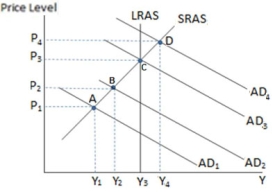 Assuming the economy represented in the graph shown is currently at point B, if the government does nothing, then eventually:
Assuming the economy represented in the graph shown is currently at point B, if the government does nothing, then eventually:A) SRAS will shift to the right, and the economy will have Y3 output with lower prices.
B) SRAS will shift left, and the economy will experience stagflation.
C) LRAS will shift left, until lower equilibrium output is reached with lower prices.
D) the entire economy will collapse.

Unlock Deck
Unlock for access to all 115 flashcards in this deck.
Unlock Deck
k this deck
42
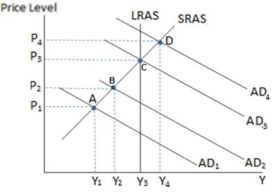 If the economy in the graph shown were at point B, and the government wished to bring the economy back to its long-run equilibrium, it might:
If the economy in the graph shown were at point B, and the government wished to bring the economy back to its long-run equilibrium, it might:A) increase government spending.
B) increase income tax.
C) decrease tax credits.
D) All of these would move the economy to its potential GDP from point B

Unlock Deck
Unlock for access to all 115 flashcards in this deck.
Unlock Deck
k this deck
43
 According to the graph shown, if the government decides to increase taxes, it is most likely at equilibrium:
According to the graph shown, if the government decides to increase taxes, it is most likely at equilibrium:A) A
B) B
C) C
D) D

Unlock Deck
Unlock for access to all 115 flashcards in this deck.
Unlock Deck
k this deck
44
If the government enacts contractionary fiscal policy, it:
A) must want to slow economic activity.
B) could increase taxes.
C) expects aggregate demand to decrease.
D) All of these are true.
A) must want to slow economic activity.
B) could increase taxes.
C) expects aggregate demand to decrease.
D) All of these are true.

Unlock Deck
Unlock for access to all 115 flashcards in this deck.
Unlock Deck
k this deck
45
Economist John Maynard Keynes is famous for saying, "In the long run, we are all dead." He is referring to the:
A) length of time it can take the economy to recover to potential GDP without policy intervention.
B) permanent inflation that results in long-run adjustments.
C) fact that no policy can affect the long-run equilibrium.
D) notion the economy is sure to collapse in the long run.
A) length of time it can take the economy to recover to potential GDP without policy intervention.
B) permanent inflation that results in long-run adjustments.
C) fact that no policy can affect the long-run equilibrium.
D) notion the economy is sure to collapse in the long run.

Unlock Deck
Unlock for access to all 115 flashcards in this deck.
Unlock Deck
k this deck
46
The goal of expansionary fiscal policy with respect to output is to:
A) increase spending and shift aggregate demand to the right in an effort to reach full employment output.
B) increase spending and aggregate demand to get back to an output level the government is comfortable with.
C) decrease government spending in an attempt to get the private economy back on track.
D) increase spending and shift aggregate demand to the left in an effort to reach full employment output.
A) increase spending and shift aggregate demand to the right in an effort to reach full employment output.
B) increase spending and aggregate demand to get back to an output level the government is comfortable with.
C) decrease government spending in an attempt to get the private economy back on track.
D) increase spending and shift aggregate demand to the left in an effort to reach full employment output.

Unlock Deck
Unlock for access to all 115 flashcards in this deck.
Unlock Deck
k this deck
47
 If the economy in the graph shown is currently at point D, we can conclude the:
If the economy in the graph shown is currently at point D, we can conclude the:A) economy is in an economic boom.
B) government may want to enact contractionary fiscal policy.
C) unemployment rate is likely very low.
D) All of these are likely to be true.

Unlock Deck
Unlock for access to all 115 flashcards in this deck.
Unlock Deck
k this deck
48
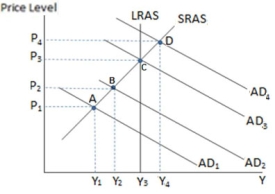 According to the graph shown, if the government decides to increase its spending, it is most likely at point:
According to the graph shown, if the government decides to increase its spending, it is most likely at point:A) C
B) B
C) D
D) It's impossible to tell without more information.

Unlock Deck
Unlock for access to all 115 flashcards in this deck.
Unlock Deck
k this deck
49
One reason the government enacts fiscal policy instead of waiting for the economy to correct itself is the automatic adjustment:
A) can take a very long time.
B) means a lower level of potential GDP.
C) will cause permanent inflation.
D) is generally not supported by government officials.
A) can take a very long time.
B) means a lower level of potential GDP.
C) will cause permanent inflation.
D) is generally not supported by government officials.

Unlock Deck
Unlock for access to all 115 flashcards in this deck.
Unlock Deck
k this deck
50
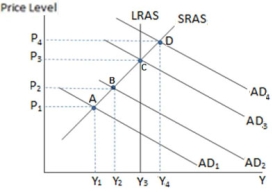 If the government enacts contractionary fiscal policy, it is most likely at which of the following equilibria in the graph shown?
If the government enacts contractionary fiscal policy, it is most likely at which of the following equilibria in the graph shown?A) A
B) B
C) C
D) D

Unlock Deck
Unlock for access to all 115 flashcards in this deck.
Unlock Deck
k this deck
51
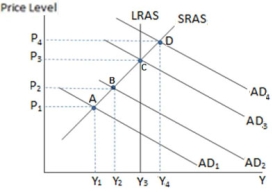 According to the graph shown, the consequence of expansionary fiscal policy is:
According to the graph shown, the consequence of expansionary fiscal policy is:A) inflation.
B) deflation.
C) a greater level of potential output.
D) a lower level of potential output.

Unlock Deck
Unlock for access to all 115 flashcards in this deck.
Unlock Deck
k this deck
52
Economist John Maynard Keynes once said, "In the long run, we are all dead." Keynes was likely:
A) in favor of using fiscal policy.
B) against the use of fiscal policy.
C) in favor of allowing the economy to always correct itself.
D) Economy never achieves its long run equilibrium.
A) in favor of using fiscal policy.
B) against the use of fiscal policy.
C) in favor of allowing the economy to always correct itself.
D) Economy never achieves its long run equilibrium.

Unlock Deck
Unlock for access to all 115 flashcards in this deck.
Unlock Deck
k this deck
53
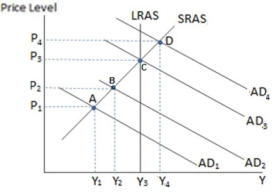 Assuming the economy in the graph shown is currently at equilibrium A, if the government wanted to enact a policy it would likely enact:
Assuming the economy in the graph shown is currently at equilibrium A, if the government wanted to enact a policy it would likely enact:A) expansionary fiscal policy in an effort to move aggregate demand to the right.
B) contractionary fiscal policy in an effort to move aggregate demand to the left.
C) expansionary fiscal policy in an effort to move aggregate demand to the left.
D) contractionary fiscal policy in an effort to move aggregate demand to the right.

Unlock Deck
Unlock for access to all 115 flashcards in this deck.
Unlock Deck
k this deck
54
Keynesian policy:
A) refers to policies that actively shift aggregate demand in an effort to reach full employment.
B) refers to fiscal policy.
C) promotes spending more and taxing less to boost economic activity to potential GDP.
D) All of these are true.
A) refers to policies that actively shift aggregate demand in an effort to reach full employment.
B) refers to fiscal policy.
C) promotes spending more and taxing less to boost economic activity to potential GDP.
D) All of these are true.

Unlock Deck
Unlock for access to all 115 flashcards in this deck.
Unlock Deck
k this deck
55
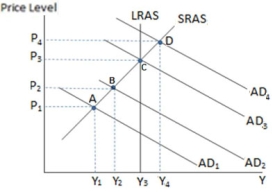 If the economy in the graph shown is at point D, and the government wished to bring the economy back to its long-run equilibrium, it might:
If the economy in the graph shown is at point D, and the government wished to bring the economy back to its long-run equilibrium, it might:A) increase government spending.
B) decrease income taxes.
C) increase corporate income taxes.
D) All of these would bring the economy back to potential GDP.

Unlock Deck
Unlock for access to all 115 flashcards in this deck.
Unlock Deck
k this deck
56
Fiscal policy can:
A) have real effects on the economy in the short run.
B) bring the economy to its long run equilibrium faster than it can correct itself.
C) cause inflation.
D) All of these are true.
A) have real effects on the economy in the short run.
B) bring the economy to its long run equilibrium faster than it can correct itself.
C) cause inflation.
D) All of these are true.

Unlock Deck
Unlock for access to all 115 flashcards in this deck.
Unlock Deck
k this deck
57
 Assuming the economy in the graph shown is currently at equilibrium A, we can conclude:
Assuming the economy in the graph shown is currently at equilibrium A, we can conclude:A) the economy is in a recession.
B) the economy is producing less than its potential level of output.
C) there must be unemployment of resources.
D) All of these are true.

Unlock Deck
Unlock for access to all 115 flashcards in this deck.
Unlock Deck
k this deck
58
When the government enacts fiscal policy, it:
A) may not always be able to improve matters.
B) might make things worse.
C) can bring the economy to its long-run equilibrium more quickly than it can correct itself.
D) All of these are true.
A) may not always be able to improve matters.
B) might make things worse.
C) can bring the economy to its long-run equilibrium more quickly than it can correct itself.
D) All of these are true.

Unlock Deck
Unlock for access to all 115 flashcards in this deck.
Unlock Deck
k this deck
59
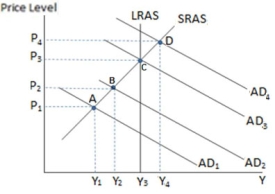 If the economy in the graph shown is currently at point B, and the government increases its spending, the likely outcome will be that the:
If the economy in the graph shown is currently at point B, and the government increases its spending, the likely outcome will be that the:A) economy will increase its level of output.
B) economy will experience deflation.
C) economy's unemployment rate will increase.
D) All of these are likely to be true.

Unlock Deck
Unlock for access to all 115 flashcards in this deck.
Unlock Deck
k this deck
60
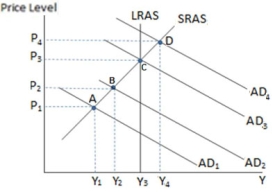 If the economy in the graph shown is currently at point B, and the government enacts contractionary fiscal policy, in the short run the economy will most likely move to point:
If the economy in the graph shown is currently at point B, and the government enacts contractionary fiscal policy, in the short run the economy will most likely move to point:A) A
B) It is likely to be unaffected and stay at point B
C) C
D) D

Unlock Deck
Unlock for access to all 115 flashcards in this deck.
Unlock Deck
k this deck
61
Increased government spending on unemployment insurance during a recession is an example of:
A) an automatic stabilizer.
B) discretionary fiscal policy.
C) expansionary fiscal policy.
D) contractionary fiscal policy.
A) an automatic stabilizer.
B) discretionary fiscal policy.
C) expansionary fiscal policy.
D) contractionary fiscal policy.

Unlock Deck
Unlock for access to all 115 flashcards in this deck.
Unlock Deck
k this deck
62
The existing tax rates on income in the United States:
A) act as an automatic stabilizer.
B) curtail spending slightly when incomes rise because people have to pay more in taxes when incomes are high.
C) encourage spending slightly when incomes fall because people pay less in taxes when incomes are low.
D) All of these are true.
A) act as an automatic stabilizer.
B) curtail spending slightly when incomes rise because people have to pay more in taxes when incomes are high.
C) encourage spending slightly when incomes fall because people pay less in taxes when incomes are low.
D) All of these are true.

Unlock Deck
Unlock for access to all 115 flashcards in this deck.
Unlock Deck
k this deck
63
When output deviates from potential GDP, automatic stabilizers work to push the economy:
A) in the same direction that correctly timed and formulated discretionary policy would.
B) in the opposite direction that correctly timed and formulated discretionary policy would.
C) in unpredictable ways, causing a need for discretionary policy.
D) even further from its long-run equilibrium.
A) in the same direction that correctly timed and formulated discretionary policy would.
B) in the opposite direction that correctly timed and formulated discretionary policy would.
C) in unpredictable ways, causing a need for discretionary policy.
D) even further from its long-run equilibrium.

Unlock Deck
Unlock for access to all 115 flashcards in this deck.
Unlock Deck
k this deck
64
Johnny has been working a lot of overtime during the most current economic boom. As a result, his income is high enough for him to move from the 10 percent tax bracket to the 15 percent tax bracket. So, Johnny pays a higher percentage of a higher income to the government this year. The increased amount paid to the government is an example of:
A) discretionary fiscal policy slowing the economy.
B) automatic stabilizers slowing the economy.
C) discretionary fiscal policy encouraging economic activity.
D) automatic stabilizers encouraging economic activity.
A) discretionary fiscal policy slowing the economy.
B) automatic stabilizers slowing the economy.
C) discretionary fiscal policy encouraging economic activity.
D) automatic stabilizers encouraging economic activity.

Unlock Deck
Unlock for access to all 115 flashcards in this deck.
Unlock Deck
k this deck
65
The amount of time it takes for fiscal policy to have an impact on the economy creates:
A) an information lag.
B) a formulation lag.
C) an implementation lag.
D) a direction lag.
A) an information lag.
B) a formulation lag.
C) an implementation lag.
D) a direction lag.

Unlock Deck
Unlock for access to all 115 flashcards in this deck.
Unlock Deck
k this deck
66
When an economy is in an economic boom, discretionary fiscal policy would call for _____________, and the automatic stabilizers would _____________.
A) lowering tax rates; lower tax revenues
B) lowering tax revenues; lower tax rates
C) increasing tax rates; increase tax revenues
D) increasing tax rates; lower tax revenues
A) lowering tax rates; lower tax revenues
B) lowering tax revenues; lower tax rates
C) increasing tax rates; increase tax revenues
D) increasing tax rates; lower tax revenues

Unlock Deck
Unlock for access to all 115 flashcards in this deck.
Unlock Deck
k this deck
67
The process of deciding on and passing fiscal policy legislation creates:
A) an information lag.
B) a formulation lag.
C) an implementation lag.
D) a direction lag.
A) an information lag.
B) a formulation lag.
C) an implementation lag.
D) a direction lag.

Unlock Deck
Unlock for access to all 115 flashcards in this deck.
Unlock Deck
k this deck
68
If the government engages in contractionary fiscal policy a likely reason would be:
A) they think the economy is not growing fast enough and they want to speed it up.
B) people are not spending enough money and they want to boost spending.
C) the economy is operating at a level that is just below full employment.
D) they think the economy is growing too quickly and they want to slow it down.
A) they think the economy is not growing fast enough and they want to speed it up.
B) people are not spending enough money and they want to boost spending.
C) the economy is operating at a level that is just below full employment.
D) they think the economy is growing too quickly and they want to slow it down.

Unlock Deck
Unlock for access to all 115 flashcards in this deck.
Unlock Deck
k this deck
69
Fiscal policy that the government actively chooses to adopt is called:
A) automatic stabilizing policy.
B) discretionary fiscal policy.
C) monetary policy.
D) contractionary policy.
A) automatic stabilizing policy.
B) discretionary fiscal policy.
C) monetary policy.
D) contractionary policy.

Unlock Deck
Unlock for access to all 115 flashcards in this deck.
Unlock Deck
k this deck
70
A difficulty with effective fiscal policy is the:
A) reality of time lags.
B) guess as to what potential GDP is.
C) lack of relevant information needed to decide the magnitude of change.
D) All of these are true.
A) reality of time lags.
B) guess as to what potential GDP is.
C) lack of relevant information needed to decide the magnitude of change.
D) All of these are true.

Unlock Deck
Unlock for access to all 115 flashcards in this deck.
Unlock Deck
k this deck
71
Maude is complaining about how much she pays in taxes now that the economy is finally doing really well. Even though she's in the same tax bracket as she was last year, she's paying $500 more in taxes this year, just because she earned more overtime pay this year. Maude's increased tax payment to the government is an example of:
A) expansionary fiscal policy.
B) contractionary fiscal policy.
C) discretionary fiscal policy.
D) automatic stabilizers.
A) expansionary fiscal policy.
B) contractionary fiscal policy.
C) discretionary fiscal policy.
D) automatic stabilizers.

Unlock Deck
Unlock for access to all 115 flashcards in this deck.
Unlock Deck
k this deck
72
A lack of understanding regarding the current state of the economy creates:
A) an information lag.
B) a formulation lag.
C) an implementation lag.
D) a direction lag.
A) an information lag.
B) a formulation lag.
C) an implementation lag.
D) a direction lag.

Unlock Deck
Unlock for access to all 115 flashcards in this deck.
Unlock Deck
k this deck
73
Automatic stabilizers are the:
A) taxes and government spending that affect fiscal policy without specific action from policymakers.
B) fiscal policies that government actively chooses to adopt.
C) expansionary fiscal policies.
D) Keynesian policies.
A) taxes and government spending that affect fiscal policy without specific action from policymakers.
B) fiscal policies that government actively chooses to adopt.
C) expansionary fiscal policies.
D) Keynesian policies.

Unlock Deck
Unlock for access to all 115 flashcards in this deck.
Unlock Deck
k this deck
74
When an economy is in a recession, discretionary fiscal policy would call for ________, and the automatic stabilizers would ____________.
A) lowering tax rates; lower tax revenues
B) increasing tax rates; increase tax revenues
C) increasing tax revenues; increase tax rates
D) increasing tax rates, lower tax revenues.
A) lowering tax rates; lower tax revenues
B) increasing tax rates; increase tax revenues
C) increasing tax revenues; increase tax rates
D) increasing tax rates, lower tax revenues.

Unlock Deck
Unlock for access to all 115 flashcards in this deck.
Unlock Deck
k this deck
75
One of the main difficulties with implementing fiscal policy is:
A) the time lag between the time the policy is chosen and the time it gets enacted.
B) deciding on a policy without all the relevant information.
C) the danger in overshooting or undershooting the goal of full employment.
D) All of these are true.
A) the time lag between the time the policy is chosen and the time it gets enacted.
B) deciding on a policy without all the relevant information.
C) the danger in overshooting or undershooting the goal of full employment.
D) All of these are true.

Unlock Deck
Unlock for access to all 115 flashcards in this deck.
Unlock Deck
k this deck
76
During times of economic boom, the spending on unemployment insurance:
A) likely falls, since more people are working.
B) likely goes up, since wages typically rise during booms.
C) likely stays the same, as government spending is through set criteria and unaffected by the business cycle.
D) is usually based on discretionary fiscal policy.
A) likely falls, since more people are working.
B) likely goes up, since wages typically rise during booms.
C) likely stays the same, as government spending is through set criteria and unaffected by the business cycle.
D) is usually based on discretionary fiscal policy.

Unlock Deck
Unlock for access to all 115 flashcards in this deck.
Unlock Deck
k this deck
77
Taxes and government spending that affect fiscal policy without specific action from policymakers are called:
A) automatic stabilizers.
B) discretionary fiscal policy.
C) expansionary fiscal policy.
D) contractionary fiscal policy.
A) automatic stabilizers.
B) discretionary fiscal policy.
C) expansionary fiscal policy.
D) contractionary fiscal policy.

Unlock Deck
Unlock for access to all 115 flashcards in this deck.
Unlock Deck
k this deck
78
Lags in the policy-making process come from:
A) lack of understanding the current state of the economy.
B) the process of deciding on and passing legislation.
C) the time it takes for policy to have an impact on the economy.
D) All of these are true.
A) lack of understanding the current state of the economy.
B) the process of deciding on and passing legislation.
C) the time it takes for policy to have an impact on the economy.
D) All of these are true.

Unlock Deck
Unlock for access to all 115 flashcards in this deck.
Unlock Deck
k this deck
79
When government decides to use fiscal policy:
A) the information for how much to change taxes is readily available.
B) the expedited process of approval aids with quick enactment.
C) it always keeps the economy closer to potential GDP than it otherwise would be.
D) It may take time to implement it.
A) the information for how much to change taxes is readily available.
B) the expedited process of approval aids with quick enactment.
C) it always keeps the economy closer to potential GDP than it otherwise would be.
D) It may take time to implement it.

Unlock Deck
Unlock for access to all 115 flashcards in this deck.
Unlock Deck
k this deck
80
Discretionary fiscal policy is:
A) fiscal policy that the government actively chooses to adopt.
B) taxes and government spending that affect fiscal policy without specific action from policymakers.
C) fiscal policy that the government enacts only for a short period of time.
D) taxes and government spending that the government actively votes against adoption.
A) fiscal policy that the government actively chooses to adopt.
B) taxes and government spending that affect fiscal policy without specific action from policymakers.
C) fiscal policy that the government enacts only for a short period of time.
D) taxes and government spending that the government actively votes against adoption.

Unlock Deck
Unlock for access to all 115 flashcards in this deck.
Unlock Deck
k this deck



